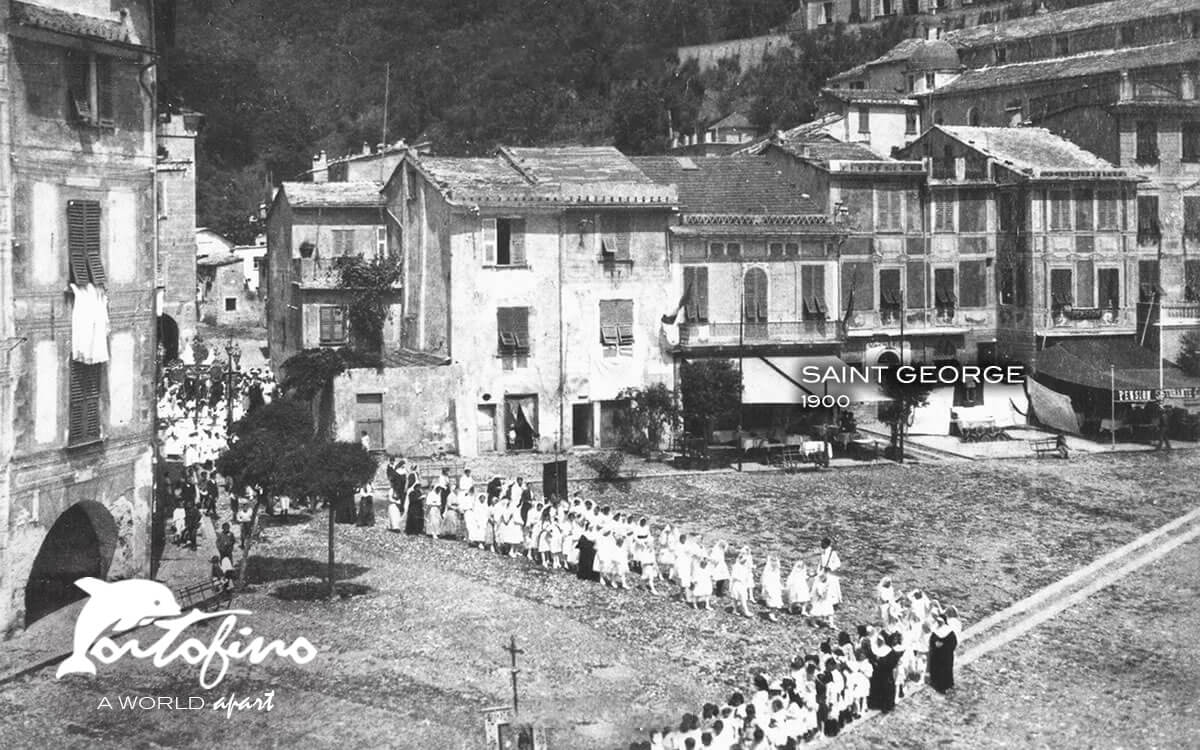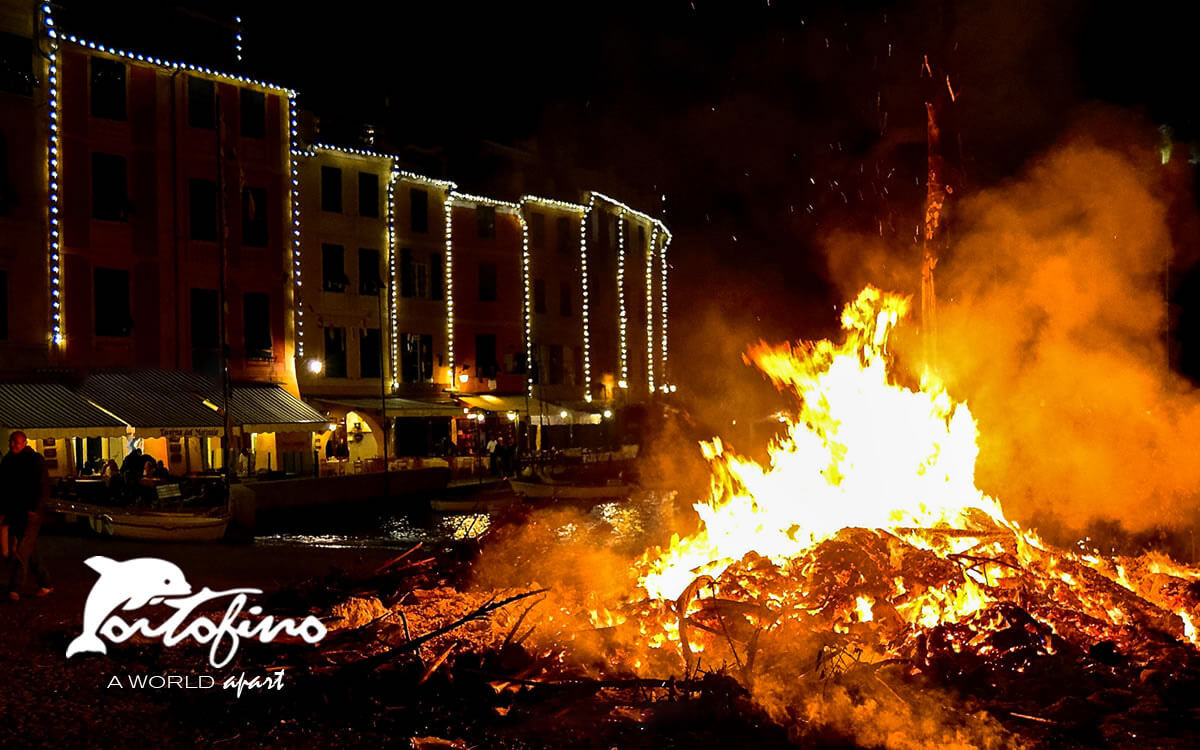
The Saint George Bonfire every April 23rd
For centuries the small church of Saint George in Portofino has stood on the isthmus in domination of two halves, two human destinies: that of the open sea and that of the sea enclosed in the small port of Portofino. This church conserves a ritual that is probably unique in the world. Before leaving on long sea voyages, the sailors of Portofino wish to have the benediction of Saint George and the church bells peal out, calling the faithful to climb up the steep way to the church square to assist the sacred rite.
The priest begins mass by taking the urn containing the relics of the saint from a crypt; he puts the urn on the altar and intones the chant of this martyred soldier, «Deus tuorum militum». Then, holding the urn high in his hands, the priest goes out onto the church square and with the urn itself makes a large sign of the cross towards the open sea and another towards the port; he blesses the horizon that the sailor is going to attempt, the small port where one day the sailor wants to return and sanctifies the audacity and the peace, the fatigue and the repose, the conquest and the home, the unknown and the certitude.
This rite is very ancient and goes back to the time of the crusades. The Genoese, inhabiting the coastline, were among the first to take part in the crusades in so many numbers that on the stone of the Holy Sepulchre one reads the phrase, «Praepotens Genuentium Praesidium witnessing the strength of the Ligurian crusaders».
The seafaring people of Portofino, second to none in the art of navigation as well as faith in God, provided the Ligurian Republic with heroic sailors and captains for the galleys going to the Holy Land, and from there returned to their native country with the greater part of Saint George’s body. This soldier and martyr was beheaded in Nicomedia by Diocletian and since that time has been considered the prototype of spiritual soundness in «corpore sano»: soldier of Christ and of Rome; knight of God; killer of the dragon; symbol of audacity and justice, of strength and pureness; armed with a lance, sword and theological virtues.
In the Middle Ages the cult of Saint George spread throughout all of Christendom, and his relics, unearthed at Jaffa, were contested in the entire Catholic world. Part of the saint’s head, the lance tip, and a piece of his banner were taken to the St. George in Velabro church in Rome by the sainted Pope Zachariah. The Venetians transferred another part of the saint’s head from the island of Aegina to the St. George Maggiore Monastery in Venice: they also possess a part of his arm which was brought to Venice from the Monastery of St. George de Flore. A considerable part of his jawbone was taken from the Holy Land to Brabant in 1608. From Jerusalem, Saint Germanus, bishop of Paris, brought one of Saint George’s hands, which had been given to him by Emperor Justinian, and he put it in the church of St. Vincent. Genoa conserves a part of her patron saint’s arm which is kept in the church dedicated to him, while in the cathedral there is part of his leg and a foot closed up in a silver statue.

The Saint George Procession in Portofino
But since the XI century, the greater part of his skeletal bones have been kept on the mount of Portofinoin the humble St. George church. It was rebuilt in 1950 after having been destroyed for the fourth time in July 1944 by an airplane bomb that hit it exactly in the middle. In the vestry before the bombardment there was and ancient tablet reading, Crucesignatorum Delphini Portus — qui saeculo XI — e Palestina transvectis — Georgii M. Cappa — docensis reliquiis — patriam ditavere — hic ossa quiescunt : attesting that there lay the bones of the holy crusaders who in the XI century rendered great honor to their country by bringing the relics of Saint George from Palestine.
During the rebuilding of the church in 1950 the bones, mentioned in the tablet, were found in a well-preserved place in the old foundation, and to this find is witness the writer of these memoirs, having seen the bones with his very own eyes. Here in the new church the bones of the Portofinese crusaders lie and will lie — it is hoped — for eternity. Another tablet walled up in the church attested that the major part of the saint’s body was preserved therein and how the ancient chapel was rebuilt in 1154 by the men who fished for coral in the sea about Portofino.
Unfortunately, the only part remaining of this tablet is the heading. In a crypt carved out of the stone under the church altar and locked by four ancient bolts forming a rough cross are kept the relics of Saint George, enclosed in a small rectangular silver casket whose glass top is fastened by crossed red ribbons fixed to the edges of the casket with the seals of the bishops who authenticated the relics.
This is the miraculous urn that blesses the navigators of Portofino; whom for almost a thousand years sailors in danger on high seas have addressed their prayers to; that saved the inhabitants of Portofino from pestilence and famine as written in the papers enclosed in a metal case, preserved in the crypt under the urn. Those who escaped the plague in 1656 instituted a religious ceremony (approved by a brief from Pope Pious VII) whose celebration was very picturesque.
World War II ended on April 24,1945, on St. George’s Day, and for the population of Portofino, this date has become doubly sacred. That day, the largest procession that had ever been seen in the village made its way up to the isthmus to return the holy relics, which had been kept in the parish church during the war, to their resting place.

The procession took the creusal of St. George, shut in by the houses and steep hills for the first part then suddenly widening out over the port which that day was bathed in the bright sunlight of Tigullio’s spring. The crucifixes, supported on the sailors’ strong shoulders, arrested, wavered, and swung and the large lanterns, carried by the little children, bobbed up and down in time with their hesitant steps.
But the entire village population crowded into the procession behind the saint’s relics, so that the Creusa became a sea of color and resounded with their chanting like when the relics were carried for the first time by the crusaders (soldiers of Guglielmo Embriaco), just returned from the Holy Land.
In this way Saint George returned to his sanctuary, reduced to ruins; there among what remained of the altars, the sacred marbles, and the tabernacles the procession spread out until in a few minutes the great heap of debris was covered by a picturesque living mantle of people made up of many colors, swaying crucifixes, banners, lanterns, and crosses, with the serene sky overhead and to the right and left, the sea: the open sea which one must take and the port where one must return.
Every year St. George’s Day is celebrated in Portofino.
On the eve, of April 23rd, a great fire is made on the village square and here is burnt dry wood, the remainder of old boats, and household articles consumed during the year. On Sunday the saint’s day is solemnized with religious functions, processions, music, and fireworks following the traditional custom. Thanks to Salvator Gotta.
Portofino,a World apart.


